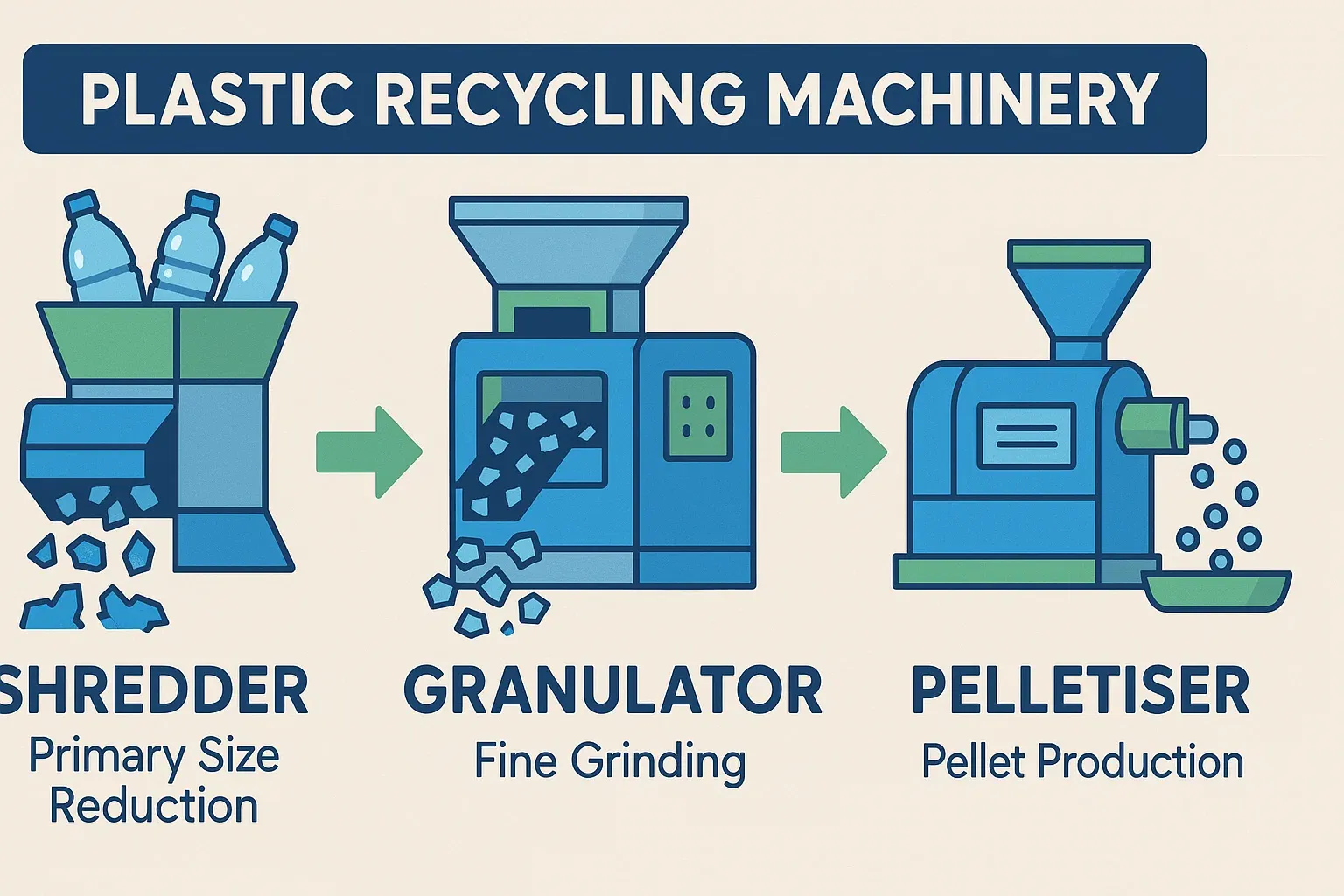Granulatorer vs. shredders vs. pelletizers: Forståelse af forskellene og synergierne
Inden for plastgenbrug er granulatorer, shreddere og pelleteringsmaskiner tre almindelige, men funktionelt forskellige udstyrsdele. Det er afgørende at have en klar forståelse af deres forskelle og indbyrdes forbindelser for at optimere genbrugsprocesser.
Makuleringsmaskine
En shredder bruges primært til den indledende størrelsesreduktion af stort, omfangsrigt eller blandet plastaffald. Den anvender typisk rive-, klippe- eller slagmetoder til at producere større stykker af uregelmæssig størrelse. Shredders fungerer ofte som forbehandlingsudstyr til granulatorer, især når man arbejder med materialer, der er for voluminøse eller vanskelige at føre direkte ind i en granulators tragt. Hovedmålet er at reducere materialevolumen for lettere efterfølgende håndtering med mindre vægt på ensartetheden af den endelige partikel.
Granulator
En granulator bruger, som navnet antyder, roterende knive med høj hastighed til at finskære og nedbryde plastik, hvilket producerer mindre, relativt ensartede partikler eller flager (ofte kaldet genformaling). Denne genformaling kan genbruges direkte i fremstillingen eller tjene som råmateriale til en pelleteringsmaskine.
Pelletiseringsmaskine
En pelleteringsenhed er typisk placeret for enden af genbrugslinjen. Den tager renset og knust (muligvis granuleret) plast, smelter det og ekstruderer det gennem et matricehoved til strenge. Disse strenge skæres derefter af en pelleteringsenhed (f.eks. vandring, luftkølet, undervands) til ensartede, salgbare plastkugler. Disse kugler har ensartet form, størrelse og bulkdensitet, hvilket gør dem lettere at opbevare, transportere og bruge i efterfølgende plaststøbningsprocesser.
Synergier i genbrugslinjer
Disse tre typer udstyr kan fungere synergistisk i en genbrugslinje. En typisk proces kan involvere: store affaldsgenstande, der først kommer ind i en shredder til grovmaling og derefter transporteres til en granulator til finmaling. Den resulterende genformaling, efter vask og tørring, føres derefter ind i en pelleteringsmaskine, hvor den smeltes, ekstruderes og skæres til færdige plastpellets. Nogle integrerede systemer kombinerer endda shredding, tilførsel og ekstrudering (pelletering) i et enkelt trin.
Den optimale konfiguration af genbrugslinjen (f.eks. shredder → granulator → pelletizer vs. granulator → pelletizer) afhænger i høj grad af formen og volumenet af det inputmateriale, samt de specifikationer, der kræves for slutproduktet. Der findes ingen enkelt "bedste" rækkefølge. Valget af udstyr og dets rækkefølge er en strategisk beslutning baseret på materialeegenskaber og forarbejdningsmål, hvilket er afgørende for ingeniører, der designer genbrugslinjer.
Konsekvenser af misforståelse af udstyrsroller
At forveksle de forskellige roller for shreddere, granulatorer og pelleteringsmaskiner kan føre til ineffektiv behandling, øget energiforbrug og lavere kvalitet af genbrugsmaterialer, hvilket i sidste ende påvirker investeringsafkastet. For eksempel vil brugen af en granulator til at behandle meget store eller seje materialer, der er mere egnede til en shredder, resultere i overdreven slid på knive og sigter, hyppige blokeringer og overbelastning af motoren. Tilsvarende er det urealistisk at forvente, at granuleret genformalet har de samme fysiske egenskaber som pelleteret granulat. En tydelig differentiering af funktionerne i dette udstyr hjælper købere med at træffe informerede investeringsbeslutninger og gør det muligt for ingeniører at designe effektive genbrugssystemer.



